U.S. Department of Transportation
Federal Highway Administration
1200 New Jersey Avenue, SE
Washington, DC 20590
202-366-4000
Federal Highway Administration Research and Technology
Coordinating, Developing, and Delivering Highway Transportation Innovations
|
Research & Technology Transporter This newsletter is an archived publication and may contain dated technical, contact, and link information. |
|
| Publication Number: N/A Date: April 2006 |
Publication Date: April 2006
|
With management of the Nation's highways now a 24-hours-a-day, 7-days-a-week enterprise, transportation professionals are more likely than ever to become involved in incident response and recovery. Those functions are thought of most often in terms of vehicle crashes, but State and local government agencies also are being called in to assist with natural disasters and to be prepared for potential terrorist attacks. Responses to such events often are managed through the Incident Command System (ICS) approach. Because many transportation professionals may be unfamiliar with to the ICS approach, the Federal Highway Administration (FHWA) recently published the Simplified Guide to the Incident Command System for Transportation Professionals (FHWA-HOP-06-004).
ICS is a systematic method for coordinating emergency responses and helps agencies aggressively manage traffic disruptions and their consequences and return the transportation system to full capacity quickly. First and foremost, ICS enables emergency response agencies, State departments of transportation (DOTs), and other stakeholders to work together using common terminology and operating procedures for controlling personnel, facilities, equipment, and communications at incident scenes.
The guide comprises six chapters as well as an extensive glossary of terms that transportation personnel may encounter at an incident scene. Even though the glossary is at the back of the guide, it is one of the most useful parts of the publication. When responders share a common understanding of terminology, response and recovery can occur in a timelier manner.
In Chapter 1, readers gain a basic understanding of the ICS approach and the types of incidents to which it may be applied. Readers learn, for example, that ICS was developed in the 1970s by fire departments in Arizona and California. Since then, many jurisdictions across the country have built on existing traffic incident and emergency management plans, systems, and capabilities to incorporate ICS into everyday incident response and removal activities.
Chapter 2 offers an overview of the ICS organizational structure. As the guide notes, the full array of the ICS structure will rarely have to be activated, as most traffic incidents are relatively minor and require only a police officer ("Incident Commander") to direct a few resources, such as a tow truck. Chapter 3 explains the importance of using, within the command function, unified command principles for multijurisdictional or multiagency incident management.
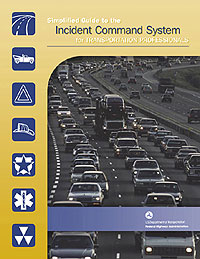 |
| Shown here is the cover of the new Simplified Guide to the Incident Command System for Transportation Professionals. The purpose of the guide is to introduce the ICS concept to stakeholders who may be called upon to provide specific expertise, assistance, or material during highway incidents. |
Chapter 4 presents strategies and tools that can help stakeholders develop ICS frameworks for day-to-day management of highway incidents. This chapter also addresses communications and resource and information management. Chapter 5 presents ICS implementation considerations for the on-scene management of highway incidents, describing the incident characteristics, resource requirements, decision criteria, and response actions that influence the scope of ICS required to manage an incident.
The sixth and final chapter encourages transportation professionals to consider how they can work more closely with public safety and other agencies. Sharing the guide with partners is a good first step. Additional steps include talking directly with fire and police departments, ensuring that agencies that might have responsibilities during large-scale highway incidents have entered into mutual aid agreements (these agencies might be in bordering States), reviewing any existing mutual aid agreements to ensure they reflect current responsibilities, conducting regular ICS training for agency staff who might be involved in incident response or preparedness planning, and becoming more involved in local area preparedness organizations focused on managing highway incidents.
Seizing the initiative and planning ahead are crucial steps for any agency. Indeed, as important as it is to understand ICS, it is equally important for professionals at State and local transportation agencies, towing and recovery firms, and other organizations to take what they have learned from the Simplified Guide and meet with their counterparts and train staff on incident management policies and procedures. Agencies also may wish to consider conducting tabletop exercises to practice the lessons learned from the guide. Such a proactive approach by transportation agencies can go a long way toward ensuring that they are prepared and are recognized as important participants in crash or disaster response.
The material in the new guide is based largely on the U.S. Department of Homeland Security's National Incident Management System (NIMS) and the Model Procedures Guide for Highway Incidents developed by the National Fire Service Incident Management System Consortium. Homeland Security Presidential Directive/HSPD-5 on management of domestic incidents requires all Federal departments and agencies to make adoption of NIMS by State, tribal, and local organizations a condition for Federal preparedness assistance. Adopting the basic tenets of ICS is one of the first steps toward achieving NIMS compliance.
For more information, contact:
Laurel Radow 202-366-2855 laurel.radow@fhwa.dot.gov
Investment in advanced or exploratory research too often is dampened by the perceived delay between the completion of projects and the application of relevant findings. For many organizations, attracting support for long-term exploratory research can be challenging due to the risk that there may be no payoff. Recognizing the need for a strong Federal role, the Federal Highway Administration (FHWA) has engaged in several activities to demonstrate its renewed corporate commitment to and focus on advanced research.
Plans for FHWA advanced research activities are incorporated in the Corporate Master Plan for Research and Deployment of Technology & Innovation (FHWA-RD-03-077). A guiding principle in the plan is to increase FHWA's focus on long-term, high-cost, high-risk research, with a specific commitment to work with stakeholders to bolster advanced research efforts. An early activity under this commitment was to establish a common definition of "advanced" research: Research that involves and draws upon basic research results to provide a better understanding of phenomena and develop innovative solutions.
The next step was to bring together government, private sector, and university researchers with FHWA managers and decisionmakers to explore possibilities for a future advanced research agenda. To do this, FHWA conducted a series of think tanks with the title "Advancing Future Transportation with Breakthrough Innovations" in the summer and fall of 2005. The think tanks enabled nearly 100 participants to be actively involved in identifying FHWA's long-term research needs. Nearly 20 speakers covered a range of topics.
During the think tanks, the participants emphasized their high level of interest and capacity to partner with FHWA in future efforts. Based on participant input, FHWA compiled information on the highest priority research needs, resulting in the development of the following six themes to help shape the Agency's advanced research agenda.
Summary reports from the think tanks are available on CD-ROM by contacting Ariam Asmerom at 202-493-3469 or ariam.asmerom@fhwa.dot.gov. FHWA's Office of Corporate Research and Technology is working with the agency's leadership to develop a new program for advanced research. Look for updates and related documents at www.fhwa.dot.gov/crt/.
Debra Elston 202-493-3181 debra.elston@fhwa.dot.gov
The performance and characteristics of today's drivers differ significantly from those of drivers in the past. Many motorists today drive curves at speeds higher than the road's design speed. In addition, the demographics of the driving population and the design of passenger cars have changed significantly over the past 50 years. Researchers, however, have conducted very few recent studies on how these changes have affected the safety and comfort of vehicle occupants, especially when they are riding through curves.
To gain a better understanding of these impacts, Carol Tan, leader of the Federal Highway Administration's Safety Management Team in the Office of Safety Research & Development, recently completed a dissertation titled An Investigation of Comfortable Lateral Acceleration on Horizontal Curves. Tan examined whether the combination of current demographics and car and horizontal curve design still allow passengers to negotiate curves comfortably at posted speed limits. For her work, Tan received the Council of University Transportation Centers' Milton Pikarsky Award for the Outstanding Ph.D. Dissertation in Science and Technology for 2005. The award is given annually to four graduate students in the transportation field for the best Ph.D. dissertations and best master of science theses.
Prior to 2004, design values for the side-friction factor, a parameter used in horizontal curve design and assumed to be a measure of the friction between a vehicle's tires and the roadway, were based on studies conducted in the 1930s and 1940s. The two objectives of Tan's study were to determine the friction factors that correspond to uncomfortable speeds on horizontal curves in a contemporary passenger car and to determine the difference between these friction factors at uncomfortable speeds and the friction factors during an impending skid when a vehicle loses control and can leave the roadway when driving through a curve.
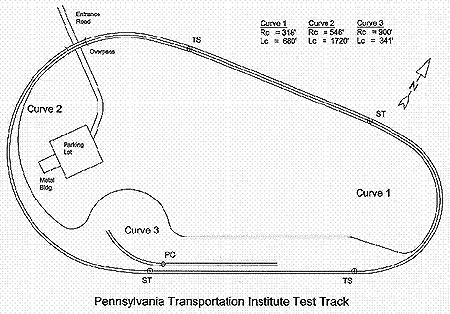 |
| A drawing of the test track used in Carol Tan's research is shown. The track is a closed loop that includes three curves. There is a parking lot for vehicles inside the track. |
To meet these objectives, Tan duplicated a methodology used in an earlier experiment, where blindfolded and unrestrained passengers served as test subjects. During Tan's study, men and women of various ages were driven around three horizontal curves at a test track. They were asked to indicate any discomfort they felt by pressing a button connected to a data collection system. "Uncomfortable" was defined as feeling a sideward pitch or desire to slow down. The curve radii were 97 meters (318 feet), 166 meters (546 feet), and 274 meters (900 feet), and speeds ranged from 56 to 88 kilometers (35 to 55 miles) per hour.
Tan compared the resulting data with the values found in the original studies of 60 years ago. Tan's data showed that approximately 90 percent of the subjects in her study were comfortable on curves built according to current standards. This means that 90 percent of the drivers might drive faster than the curves' design speeds because they experienced no discomfort at these speeds.
Tan also concluded that posted speed limits coupled with current design standards for horizontal curves, which are based on older vehicles and different passengers, still appear to provide a margin of safety and help prevent modern vehicles from skidding off the road. However, Tan questioned whether it is desirable that current road designs enable 90 percent of drivers to comfortably exceed the speed limit. In her dissertation, Tan suggests that researchers examine the implications of changing design standards so that only 50 percent of car drivers can comfortably exceed the design speed of curves.
Carol Tan 202-493-3315 carol.tan@fhwa.dot.gov
As a growing number of workers approach retirement in coming years, the need for a skilled, technically competent transportation workforce has never been more critical. To address this increasing need, the Safe, Accountable, Flexible, Efficient Transportation Equity Act: A Legacy for Users (SAFETEA-LU) includes several provisions to enhance transportation workforce development.
Section 5204(e) is of particular interest. It allows States to use core program funds for career pipeline activities for all grade levels and for programs for in-service transportation workers. A major benefit of using core funds for workforce development is that no State match is necessary.
In addition to Section 5204(e), several other parts of the new law continue, authorize, or provide funds for workforce development programs:
For more information about development of the transportation workforce, visit www.nhi.fhwa.dot.gov/transworkforce/. Additional information about the SAFETEA-LU workforce development provisions may also be obtained by contacting:
Clark Martin 703-235-0547 clark.martin@fhwa.dot.gov
Carve outs, comparables, last resort housing, in-lieu payments: Do these terms mean anything to you? Do you have a burning need to delve into the mysteries and intricacies of the Federal Relocation Assistance Program? If you are one of the Federal, State, or local agencies whose programs or projects receive or use Federal financial aid or assistance, then you will benefit from the updated Advanced Relocation course (FHWA-NHI-141030) currently being offered by the Federal Highway Administration's (FHWA) Office of Real Estate Services and National Highway Institute.
The updated course goes beyond the basics and concentrates on specific areas of concern such as mortgage differential payments and partial acquisitions. After completing the course, participants will be able to:
Advanced Relocation targets right-of-way practitioners working for government agencies; FHWA personnel; contractors; and other interested persons. Suggested prerequisites include the NHI course Basic Relocation (FHWA-NHI-141029), the Web-based course Real Estate Acquisition Under the Uniform Act: An Overview (FHWA-NHI-141045), or approximately 1 year of experience working in a relocation program.
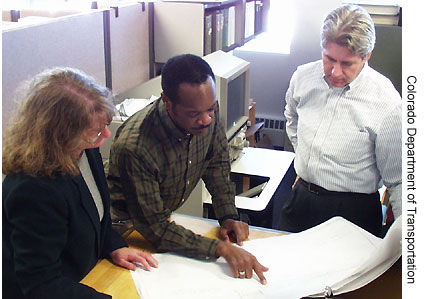 |
| A relocation assistance agent is shown meeting with property owners. (Photo Credit: Colorado Department of Transportation) |
Additional information on relocation assistance can be found on online at www.fhwa.dot.gov/realestate/index.htm. For those unable to attend a session, FHWA is developing a CD-ROM of the course materials that will be made available on this Web site. To schedule the course, call 703-235-0534 or send an e-mail to nhitraining@fhwa.dot.gov. For more information about the course, visit www.nhi.fhwa.dot.gov or contact:
Mila Plosky 703-235-0527 mila.plosky@fhwa.dot.gov
With more than 150 pedestrian fatalities each year, Georgia is one of the Federal Highway Administration's (FHWA) pedestrian safety "focus" States. FHWA defines "focus" States as those with an intersection, roadway departure, or pedestrian fatality rate above the national average. To achieve FHWA's goal of reducing the U.S. roadway fatality rate to 1.0 fatalities per 100 million vehicle miles traveled by the year 2008, FHWA encourages focus States to develop action plans to improve pedestrian safety.
To help with Georgia's plan, FHWA's Office of Safety provided technical assistance at a December 2005 workshop, "Developing a Pedestrian Safety Action Plan," in Atlanta. FHWA based the 2-day event on its guidebook How to Develop a Pedestrian Safety Action Plan (FHWA-SA-05-12). Workshop instructors taught participants about planning and designing for pedestrian safety, involving stakeholders, collecting and analyzing data, prioritizing projects, and selecting countermeasures.
Workshop participants discussed ways to improve the pedestrian safety policies and practices currently used by transportation agencies. For example, the city of Atlanta and Georgia Department of Transportation's (GDOT) current policies mandate that officials conduct engineering studies on the need for traffic signals only after someone has placed a request for a signal. At the workshop, however, the agencies committed to exploring new criteria for placing signals and to proactively examine the crash history of particular sites.
Participants also went on walking trips to two sites along Atlanta's Ponce de Leon Avenue, a corridor with high traffic volumes and pedestrian safety issues. The first site was a signalized intersection with one of the highest crash rates in the corridor due to high numbers of pedestrians, nearby bus stops, and vehicles making left and right turns. In addition, the pedestrian facilities do not comply with the Americans with Disabilities Act (ADA), creating an additional safety issue. The second site was an unsignalized "T" intersection featuring a marked crosswalk, with an apartment building for the elderly on one side and a supermarket on the other side. To cross this heavily used intersection, elderly pedestrians and others must navigate two westbound and four eastbound lanes of traffic.
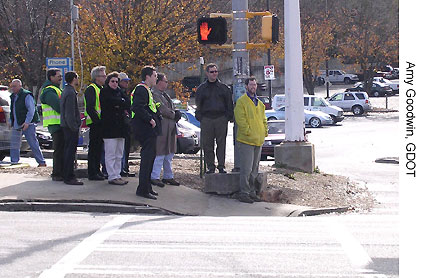 |
| Breakout groups are shown surveying an intersection on Ponce de Leon Avenue for potential pedestrian safety improvements. (Photo Credit: Amy Goodwin, GDOT) |
While the workshop participants were visiting the intersections, instructors asked them to develop countermeasures based on what they had learned in the classroom. For the first site, the participants recommended realigning a driveway median into a shopping center to prevent backups, upgrading the crossings and ramps to meet ADA requirements, and eliminating the right-turn-only lane into the shopping center. At the second site, they recommended converting the far left eastbound lane, which currently operates as a left-turn lane, into a two-way, left-turn lane, with raised pedestrian refuge islands at specific locations in the lane. In addition, they recommended converting one of the right-turn-only lanes into on-street parking. These countermeasures would narrow the roadway to four lanes.
GDOT plans to use the momentum of the workshop as a springboard to continue development of a statewide, data-driven pedestrian safety plan. For more information on the workshop, contact:
Dana Robbins 404-562-3642 dana.robbins@fhwa.dot.gov
For information on FHWA's pedestrian safety focus States, contact:
Tamara Redmon 202-366-4077 tamara.redmon@fhwa.dot.gov
Under Section 106 of the National Historic Preservation Act of 1966, the Federal Highway Administration (FHWA) must take into account and consult with Native American tribes who may have a cultural or religious association to historic properties affected by the Agency's activities. As long as tribes agree, FHWA may instead rely on State highway agencies to work with tribes. In Tennessee, for example, this traditionally meant that the Tennessee Department of Transportation (TDOT) notified tribes when it started each project. This resulted, however, in TDOT sending numerous letters and e-mails to tribal representatives, who typically provided responses on only the most critical issues, such as impacts on burial sites.
To focus correspondence on critical projects, FHWA's Tennessee Division Office launched an effort to improve communication between TDOT, FHWA, and the tribes. Initially, Division Office staff assembled a list of tribes with interests in Tennessee and determined from those tribes the specific counties that interest them. From this information, the staff developed a manual, Section 106 Consultation with American Indian Tribes in Tennessee.
The Division Office staff then organized a 1.5-day "Tennessee Tribal Consultation Workshop" in December 2005, to enable FHWA and TDOT staff to become acquainted with the tribal representatives and discuss issues of concern. The planning team for the event consisted of representatives from FHWA's Tennessee Division Office and Office of Project Development and Environmental Review, TDOT, U.S. Institute for Environmental Conflict Resolution, and representatives of several tribes. Because 12 of the 14 tribes with interests in Tennessee are located in Oklahoma, the workshop was held in Tulsa, OK.
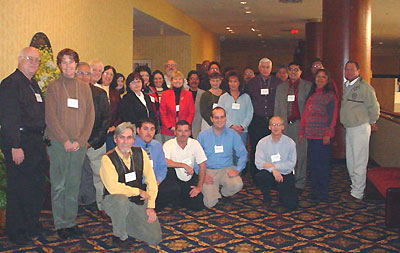 |
| Representatives from FHWA, TDOT, Native American tribes with interests in Tennessee, the U.S. Institute for Environmental Conflict Resolution, and other organizations that attended the "Tennessee Tribal Consultation Workshop" in Tulsa, OK, gather for a group photo. |
At the workshop, participants discussed the types of highway projects that the tribes wish to be notified about. The tribes agreed that some projects were not of interest to them, such as road resurfacing and guardrail replacement. Preferred methods of communication varied by tribe, with some preferring e-mail and others U.S. mail. One tribe suggested sending an e-mail with a Web site link to additional information to reduce the size of e-mails. The tribes also requested that archaeological studies on proposed projects include cultural preservation plans that discuss a project's effects on a cultural site and potential mitigation measures.
On the second day of the workshop, the group discussed items that could be included in a memorandum of understanding (MOU) between FHWA and each tribe, such as types of projects requiring consultation, maps of the tribe's areas of interest, and communication methods. The next step is for FHWA to meet with each tribe to develop a specific MOU.
Because representatives from every tribe with interests in Tennessee were unable to attend the workshop, FHWA is following up with the tribes that did not attend, and ensuring that they receive the same information as the workshop participants. For more information, contact:
Gary Fottrell 615-781-5766 gary.fottrell@fhwa.dot.gov